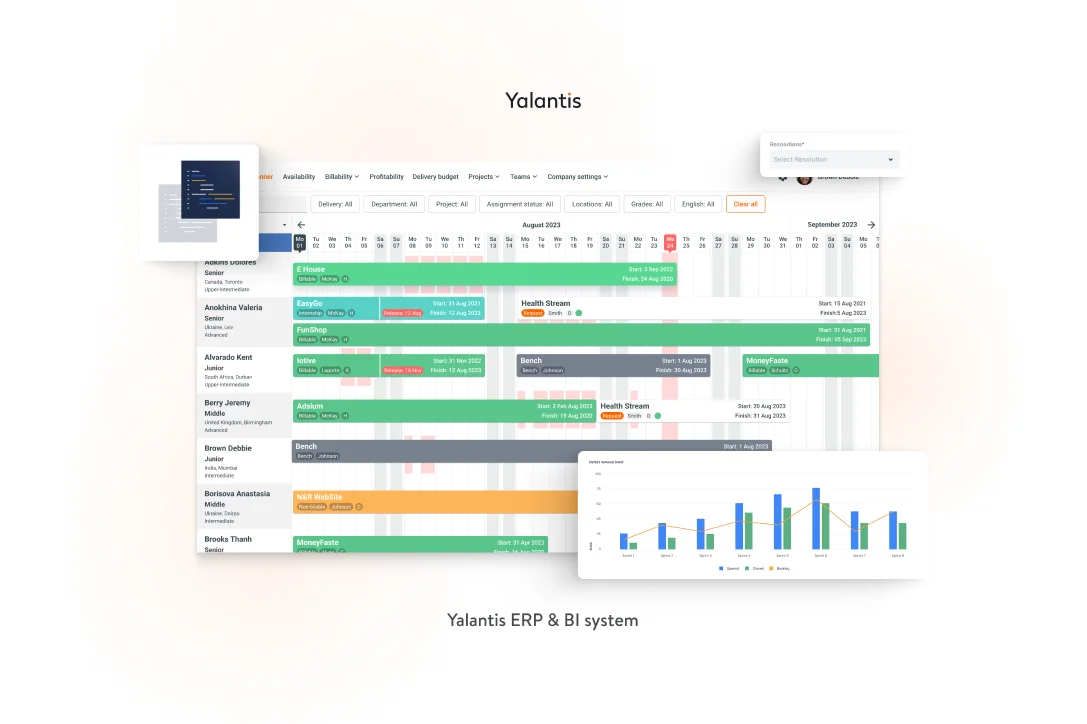40% faster decision-making with Yalantis full-fledged ERP & BI system
Discover a business intelligence (BI) solution Yalantis built for quick, informed decision-making and resource management. Integrated with all internal systems, it generates automated data-driven insights to optimize enterprise resource planning (ERP), including for the HR, project management, and finance departments.
-
Industry
IT services
-
Region
EU
-
Team size
3 IT experts
-
Period of collaboration
Jan 2022 – present
Yalantis’ data-driven road
“Our strategy is straightforward: perfect it internally, deliver excellence externally.”
– Den Rudenko, CEO of Yalantis
To scale with business growth and turn challenges into opportunities, Yalantis senior management sought to establish a data-driven culture. They tasked the internal data team with creating a centralized data source to identify trends, analyze metrics, and make informed decisions related to business processes, from people management to budgeting.
Creating the centralized data source involved optimizing internal systems (custom ERP, CEP, HRM, FinOps) to:
- efficiently consolidate data and eliminate data inconsistencies
- visualize accurate data in Tableau, the BI tool Yalantis uses

-
TRANSFORMATIVE RESULTS OF ADOPTING DATA-DRIVEN OPERATIONS

The result Yalantis data and BI engineers delivered was a sophisticated in-house ERP & BI system. The solution:
- automatically retrieves data from other internal systems to visualize it in Tableau
- offers the necessary visibility into operational and HRM processes to enhance efficiency
Specific examples of the value Yalantis has gained from the system include:

-
BUSINESS AND OPERATIONAL CHALLENGES SOLVED
With the in-house data solution, Yalantis has eliminated:
- Slow business insights. Disconnected systems and manual data collection often delayed reporting and analytics.
- Data silos. Valuable business data was trapped across internal systems, making a unified business view impossible.
- Data overload. A flood of data from emails, documents, chats, and other unstructured sources was overwhelming to store and analyze.
- Overburdened teams. Yalantis teams required more self-service access to data.
-
IMPLEMENTATION OVERVIEW
To gain business value from data, the Yalantis team started by setting up a data governance framework to:
- guarantee accurate, secure data that supports business initiatives and operations
- specify how various data sets should seamlessly integrate and interact
The process then consisted of three key stages:
-
Stage #1: Enabling a unified data view across the company with data pipelines

Yalantis data engineers created well-governed data pipelines that securely and efficiently move data to its destination to drive analytics and decision-making. They did this by:
- orchestrating data workflows with Apache Airflow to schedule and automate extract, transform, and load (ETL) tasks to process data from internal systems and manual files
- cleansing, shaping, and validating data using Python packages (Pandas) for efficient data manipulation and transformation
preparing quality data for analysis with Tableau Prep’s visualization tools - extracting data from QuickBooks and Pipedrive (which Tableau cannot connect to) using APIs and database connectors
- loading processed data into the centralized data storage (Yalantis DWH) powered by PostgreSQL to provide scalable SQL-based data warehousing and analytics capabilities
- monitoring pipelines to quickly identify and resolve any data flow failures, ensuring reliable and accurate data delivery

-
Stage #2: Optimizing data input and retrieval for better operational efficiency
Yalantis data engineers worked with business analysts to restructure the data foundation and optimize methods for entering and retrieving data across internal CEP, HRM, and other systems. They did this by:
- creating a centralized data dictionary that documents all data elements, definitions, structures, owners, etc. in one unified metadata repository.
- reducing data duplication by designating the data dictionary as the single source of truth instead of having separate definitions across systems.
- making internal systems independent to save employees’ time. For example, the HRM system no longer has to query the CEP or ERP system for employee data. It stores relevant fields locally as numerical IDs that link back to the dictionary, reducing data redundancy.
- optimizing data access for quicker systems operation. Yalantis engineers consolidated all databases, creating a centralized database for internal systems. Now, changes are instantly reflected across systems. For instance, when an employee’s grade is updated in CEP, that information now automatically flows to ERP, HRM, and FinOps.
-
Stage #3: Uncovering business insights via interdepartmental process visibility

To enable comprehensive data-driven insights, Yalantis management systematically gathers and processes data from across the organization. This involves:
- leveraging ERP integrations with channels like Jira, Slack, and email to get a convenient consolidated view of operations and processes.
- uncovering correlations between parameters with multivariate analysis that would be impossible to see in isolated data sets: for example, analyzing the relationship between assignment duration and task order processing to improve resource management and inform staffing decisions.
- discovering correlations, such as noticing that staffing without proper task order processing negatively impacts key metrics like project success rate and gross profit margin.
- identifying issues that may be missed from a single lens with holistic analysis. For instance, spotting that department X lacks individual development plans (IDPs) by combining perspectives from HR, mentors, and the department itself.
-
RESULTS: A COMPREHENSIVE ERP SYSTEM FOR RESOURCE MANAGEMENT

With a data-driven approach, Yalantis efficiently scales all business activities, turning initial challenges into strategic advantages.

-
WHAT’S NEXT?
Yalantis aims to encompass all company activities with data, establishing a comprehensive data lake to achieve:
- full company coverage through a data-driven approach
- use of data for AI, predictions, and continuous growth
To reach these goals, Yalantis expert teams are currently migrating data to a data warehouse, creating a centralized hub for crucial information, supported by business intelligence for in-depth analysis.
Leverage all your company data fast with a customizable system
Make smart decisions faster with the Yalantis ERP & BI solution, a ready-to-use system that adapts to your unique business needs.
More projects
-

Data lifecycle management in food manufacturing
A scalable data foundation to enable data-driven decision-making for strategic insights
-

Supply chain big data analytics system
A solution for a 3PL company to ensure unified access to business data and in-depth data analytics
-

Business intelligence for banking
Business intelligence for improved operational efficiency and cost optimization